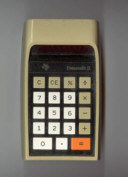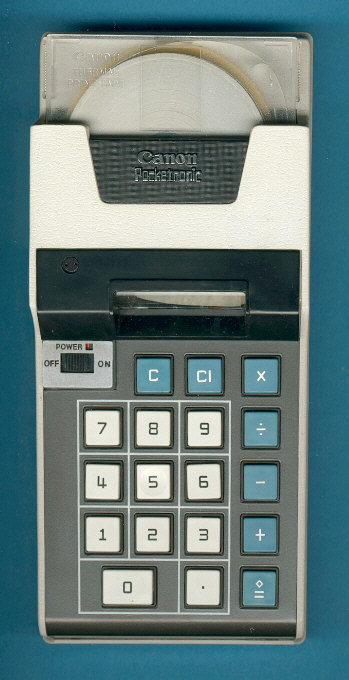
DATAMATH CALCULATOR MUSEUM
 |
DATAMATH CALCULATOR MUSEUM |
Canon Pocketronic
| Date of introduction: | April 1970 | Display technology: | |
| New price: | $395 | Display size: | n.a. |
| Size: | 8.2" x 4.0" x
1.9" 208 x 101 x 49 mm3 |
Printer technology: | Thermal |
| Weight: | 31.8 ounces, 902 grams | Serial No: | 410383 |
| Batteries: | 6*NiCd AA + 7*NiCd 2/3AA | Date of manufacture: | year 1972 |
| AC-Adapter: | Charger 21 | Origin of manufacture: | Japan |
| Precision: | Integrated circuits: | TMC1730, TMC1731, TMC1732, SN21893 | |
| Memories: | |||
| Program steps: | Courtesy of: | Joerg Woerner |
 Today
we can assume that the people at Canon Inc. were heavily impressed by the Cal-Tech
project started at Texas Instruments in September 1965 and finished in 1967. Both
companies developed together the Canon Pocketronic, the first calculator based
on Large-Scale-Integrated (LSI) circuits. A total of three LSI circuits was
necessary to do the four basic calculations with numbers of 6 to 12 digits. The
production of the calculator was done in Japan but uses a lot of components
manufactured by Texas Instruments. Beside the LSI chips they delivered the
print head of the thermal printer and the transistors. Please note that the
paper is running out in a horizontal matter compared to the later vertical style
of printing calculators. A nearly identical calculator was manufactured from
Canon for Monroe. Explore the rare Monroe 10.
Today
we can assume that the people at Canon Inc. were heavily impressed by the Cal-Tech
project started at Texas Instruments in September 1965 and finished in 1967. Both
companies developed together the Canon Pocketronic, the first calculator based
on Large-Scale-Integrated (LSI) circuits. A total of three LSI circuits was
necessary to do the four basic calculations with numbers of 6 to 12 digits. The
production of the calculator was done in Japan but uses a lot of components
manufactured by Texas Instruments. Beside the LSI chips they delivered the
print head of the thermal printer and the transistors. Please note that the
paper is running out in a horizontal matter compared to the later vertical style
of printing calculators. A nearly identical calculator was manufactured from
Canon for Monroe. Explore the rare Monroe 10.
This Canon Pocketronic is the most important calculator in the history of Texas Instruments and we take a closer look at it.

![]() The side view of
the Pocketronic reveals a rather sleek profile and shows the small slit for the
"serial" thermal printer used to display the results of the calculations. Please
keep in mind that in 1970 numeric LED
displays weren't commercial available. The thermal paper was sold in boxes
of five tape cartridges.
The side view of
the Pocketronic reveals a rather sleek profile and shows the small slit for the
"serial" thermal printer used to display the results of the calculations. Please
keep in mind that in 1970 numeric LED
displays weren't commercial available. The thermal paper was sold in boxes
of five tape cartridges.

 Dismantling a Canon Pocketronic manufactured in 1971 reveals
an engineering marvel with less mechanical and electronic parts than expected
neatly stuffed into the top shell of the case while the bottom shell is occupied
with a total of 13 rechargeable NiCd batteries.
Dismantling a Canon Pocketronic manufactured in 1971 reveals
an engineering marvel with less mechanical and electronic parts than expected
neatly stuffed into the top shell of the case while the bottom shell is occupied
with a total of 13 rechargeable NiCd batteries.
 The thermal printer consists mainly of a transport mechanism
(right hand side of the picture) and the print head (left hand side of the
picture). The electronics of the printer is placed next to the transport
mechanism, the featured unit sports the so-called correction chip that was
introduced around 1973 or 1974 to fix some timing issues of the original
discrete design.
The thermal printer consists mainly of a transport mechanism
(right hand side of the picture) and the print head (left hand side of the
picture). The electronics of the printer is placed next to the transport
mechanism, the featured unit sports the so-called correction chip that was
introduced around 1973 or 1974 to fix some timing issues of the original
discrete design.
 Most of the electronics of the Pocketronic is not immediately
visible, it is sandwiched below the electronics of the printer mechanism and
fitted into three Integrated Circuits (ICs). These chips with part numbers
TMC1730, TMC1731, and TMC1732 are manufactured in a "state of the art"
10-micron 1-metal PMOS process and using Dual-Inline Ceramic or
Plastic (DIC/DIP) packages with 40 pins and 28 pins. Please find an overview of
more later ICs developed and manufactured by Texas Instruments for Canon
here.
Most of the electronics of the Pocketronic is not immediately
visible, it is sandwiched below the electronics of the printer mechanism and
fitted into three Integrated Circuits (ICs). These chips with part numbers
TMC1730, TMC1731, and TMC1732 are manufactured in a "state of the art"
10-micron 1-metal PMOS process and using Dual-Inline Ceramic or
Plastic (DIC/DIP) packages with 40 pins and 28 pins. Please find an overview of
more later ICs developed and manufactured by Texas Instruments for Canon
here.

 The backside if the Pocketronic provides a condensed form of
the instructions manual, the serial number and the voltage rating of the
external charger.
The backside if the Pocketronic provides a condensed form of
the instructions manual, the serial number and the voltage rating of the
external charger.
One of the PCBs of the Pocketronic changed over time, please
find picture of three different calculator versions here.
The Pocketronic was later replaced with the Pocketronic II, creating a massive headache for both Canon's Product Manager and TI's Engineering Team.
The next calculators in Canon's line was the L121 using four instead the three LSI circuits driving a 12-digit Nixie tube display. Within some month both the desktop model L100 and the the wonderful pocket sized LE-10 appeared.
Don't miss the Sharp EL-8 and Sanyo ICC-82D.
If you have additions to the above article please email: joerg@datamath.org.
© Joerg Woerner, December 5, 2001. No reprints without written permission.